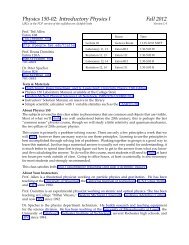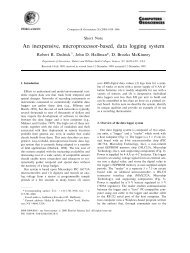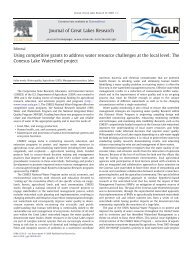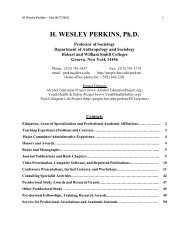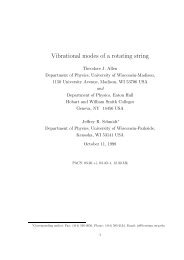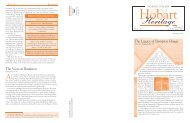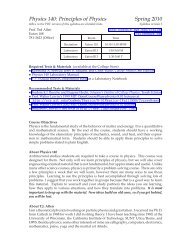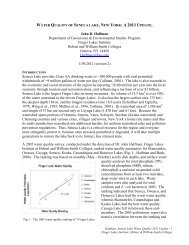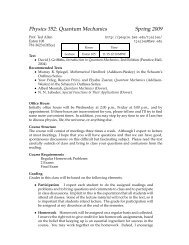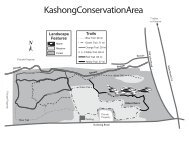Geology of New Zealand Field Trip Guidebook - ResearchGate
Geology of New Zealand Field Trip Guidebook - ResearchGate
Geology of New Zealand Field Trip Guidebook - ResearchGate
Create successful ePaper yourself
Turn your PDF publications into a flip-book with our unique Google optimized e-Paper software.
Volcanic Center and examine some <strong>of</strong> the hazards that arise when humans live in proximity<br />
to active volcanoes.<br />
Tongariro Volcanic Center—Welcome to the heart <strong>of</strong> Mordor. This andesitic center is the<br />
youngest on the North Island. It consists <strong>of</strong> the volcanoes Tongariro (1967 m), Ngauruhoe<br />
(2287 m), and Ruapehu (2797 m, the highest point on the North Island. If the weather is fine,<br />
you can see the Tasman Sea to the west and the Pacific to the east from the crater rim <strong>of</strong><br />
Ruapehu. It truly is a compact country!). Ngauruhoe is a satellite vent <strong>of</strong> Tongariro, but it<br />
has the best developed volcanic cone shape and is easy to pick out. If you’ve seen Peter<br />
Jackson’s film adaptation <strong>of</strong> “Lord <strong>of</strong> the Rings”, you might recognize it as the basis <strong>of</strong> Mt.<br />
Doom. Tongariro and Ruapehu are larger volcanic features, but because <strong>of</strong> their longer and<br />
more complex histories, they do not retain the typical stratocone volcano shape. Both have<br />
been modified by lava flows, side eruptions, lahars, landslides, small vent collapse and rock<br />
avalanches.<br />
The vent complexes (the mountains themselves) are surrounded by gently sloping<br />
“ring plains”. Eruptions seem to have begun in this area roughly a million years ago and<br />
continue to the present. Ngauruhoe last erupted in 1975 but has active fumaroles along its<br />
flanks. Ruapehu last erupted in 1995-1996.<br />
Ruapehu Volcano—Ruapehu is located at the southern end <strong>of</strong> the Taupo Volcanic Zone, a<br />
thermally expanding segment <strong>of</strong> the Earth’s crust and the source <strong>of</strong> spectacularly explosive<br />
eruptions over the last 2 million years. Because the crust is heating up here, it is expanding,<br />
creating tension, extension, normal faulting and subsidence in the central axis <strong>of</strong> the Taupo<br />
Volcanic Zone. Prominent active faults have developed to the east and west <strong>of</strong> Ruapehu<br />
volcano, which are downthrown towards the mountain. These faults mark the boundary <strong>of</strong><br />
the Taupo Volcanic Zone in this region, which terminates 20 km south <strong>of</strong> Ruapehu’s summit<br />
[Neal, 2006 #12].<br />
Accumulations <strong>of</strong> andesite lava flows interbedded with fragmental rubble radiate<br />
from the summit region forming a stratovolcano that rises 2000m from the surrounding<br />
lowlands. As stratovolcanoes build up they become steep and have a propensity to collapse,<br />
spreading outwards onto the surrounding lowlands and forming a roughly circular apron <strong>of</strong><br />
fragmented rocks (volcaniclastics) termed the “ring plain”. Ring plain deposits are mainly<br />
derived from debris avalanches and lahars, but may also include some river (fluvial) and<br />
glacial deposits. Mantling the lowlands are various thicknesses <strong>of</strong> volcanic ash forming the<br />
parent material <strong>of</strong> most <strong>of</strong> the soils in the region. Due to the dominantly westerly wind<br />
direction, ash is always considerably thicker to the east than to the west. A crater lake<br />
dominates the summit area. When full to overflowing, the lake contains 8-10 million m 3 <strong>of</strong><br />
warm to hot acid waters. Overflow <strong>of</strong> the crater lake can generate huge lahars or volcanic<br />
mud flows. Lahars have been responsible for most <strong>of</strong> the loss <strong>of</strong> life on the <strong>New</strong> <strong>Zealand</strong><br />
volcanoes (Neal et al. 2006).<br />
The oldest lava sequences preserved on Ruapehu are exposed on the northern flank and<br />
seem to date from about 300,000 years ago. The distinct stratocone was built between about<br />
250,000 and 130,000 years ago. During this period, voluminous lahars were also generated.<br />
These inundated the nearby hill country <strong>of</strong> uplifted marine siltstones, sandstones and<br />
limestones, creating the extensive ring plain, especially to the north and to the west <strong>of</strong> the<br />
Whakapapa catchment. The resultant deposits total more than 12 km 3 in volume. A second<br />
cone-building phase occurred between 60,000 and 15,000 years ago, during which time lavas<br />
<strong>of</strong> variable composition were extruded from several vents between Tahurangi and the<br />
northern Summit Plateau. Lahars were also generated during this time, leading to further<br />
deposition on the western and southwestern ring plain. Considerable volcanic ash also<br />
35




